It’s early 2025. Nothing is being hyped more than Artificial Intelligence. Hype on AI in 2025 is bigger than it was on blockchain in 2019.
While blockchain didn’t have any useful real-world purpose besides cryptocurrency, AI is different – it’s useful. We’ve all tried ChatGPT. But with the amount of hype, marketing, distraction and dreamers out there, it can be hard to ascertain exactly what you can and should use it for in your business today.
So much of the AI hype is about what it might do someday. And many people see what AI can do today, and then mentally extrapolate that and assume it can do other things, when it can’t. Tangible capabilities are important.
My angle on this, as with most things, is with applying it at scale within a business – a regular business, not an AI business – where AI must be reliable and beneficial. Of course AI is a useful product within AI businesses – where their actual business is AI, e.g. OpenAI, Microsoft, or one of the myriad other AI companies – but what about everyone else?
What kind of AI?
AI is not a single entity, process or program. AI is a series of independent algorithms that do different things. Sometimes multiple algorithms are tied together, presented in the same interface. But AI doesn’t have a personality or think in the way that humans do, even though it appears to.
When people think of AI today, most think of a ChatGPT style AI – known as an LLM. The interactivity and the natural text prompting of a LLM gives the impression that you’re interacting with an entity that has awareness. An intelligence.
But you’re not. LLMs don’t think. They’re models trained on data. If you want to learn more about how LLMs work, read this article from Andreas Stöffelbauer.
They’re also not the only kind of AI, and many of the most useful kinds of AI aren’t LLMs. E.g. Computer Vision, or Reinforcement Learning.
That’s enough preamble. Here are five things regular businesses can use AI for in 2025.
One: Image classification, recognition and search
Computer Vision AI is very good at recognising common items in images, and it can be trained to recognise more. It’s in widespread use across consumer products, like Google Photos and security cameras, and custom applications, like supermarket self-checkouts. That’s a big hint the technology is good enough for you to use in your business.
To integrate Computer Vision into your business you need to capture photo or video to feed the AI, then run the detection across the images in real time or later, depending on your need. The AI would need to be integrated with other business software (and maybe machinery) to make it useful.
For example, if you were running a fruit packaging facility, you could run a live video feed to ensure that only fruit is being packed, not other objects. If a foreign object is detected, you could either alert a human to remove (lower tech) or control a robot to move the contaminated package to the side.
As a more digital example – if you were running a real estate listing platform, you could identify which houses for sale had photos of pools, and accurately allow searching on that by the contents of images, rather than relying on accurate data input by humans.
Two: Helping humans write better
You probably know this one already. Yes, AI can help humans write better1. I feel cheeky writing this as something you can do with AI because it’s common knowledge. This is an area LLMs are good at and has been featured in ads for Google Gemini and Apple Intelligence.
I can think of two useful ways AI can help humans write better: writing standardised communications that are done infrequently, and helping to rephrase communications that are challenging.
For standardised communications – like cover letters, performance management, apologies, thank you notes, etc – it’s as simple as asking AI to write you one, with some prompting about what to include. Your staff are probably googling for templates for these now, anyway. Or using ChatGPT without your knowledge.
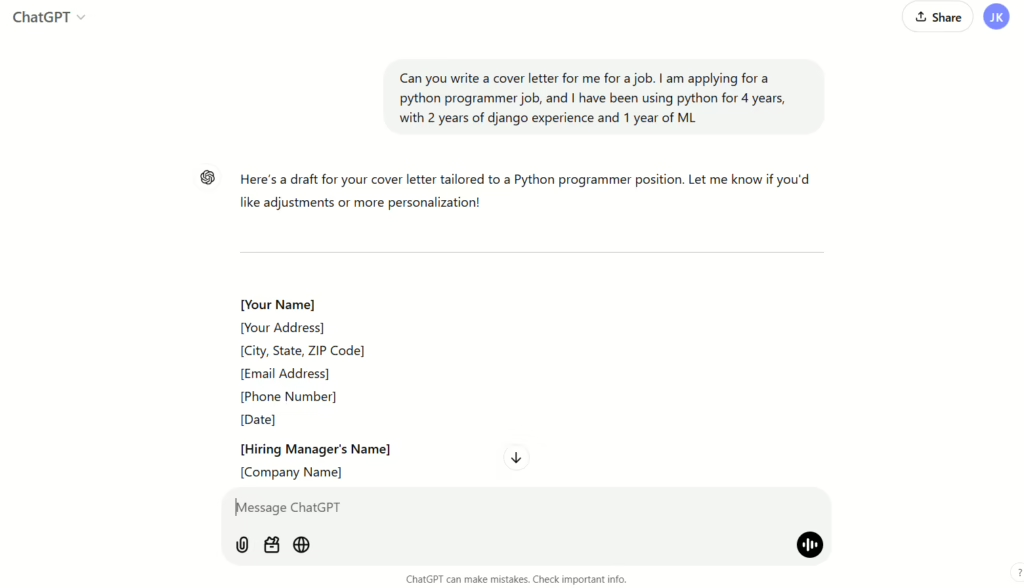
Rewriting is even more simple – ask the LLM to rewrite what you wrote, with some pointers on how you would like it improved. It can even work on quite extreme examples, like below.
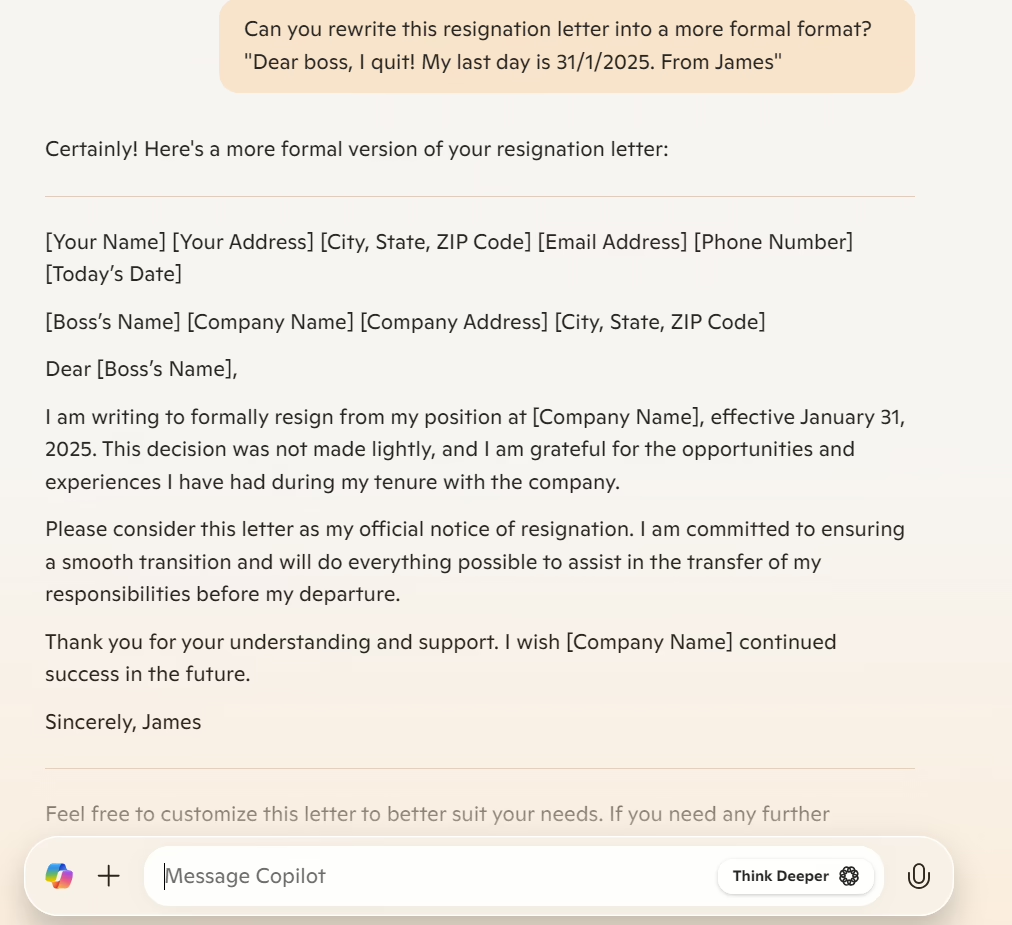
LLMs are good at rewriting because they’re trained on large volumes of quality writing. They’ve seen it before, and they reproduce it, trending towards the median of what they’ve seen. Like the pattern matching machines that they are.
There’s something they’re not, though: mind readers. Their output should be edited and checked. While the LLM will make up things to go in a communication, if a human uses it, it’s the human’s fault.
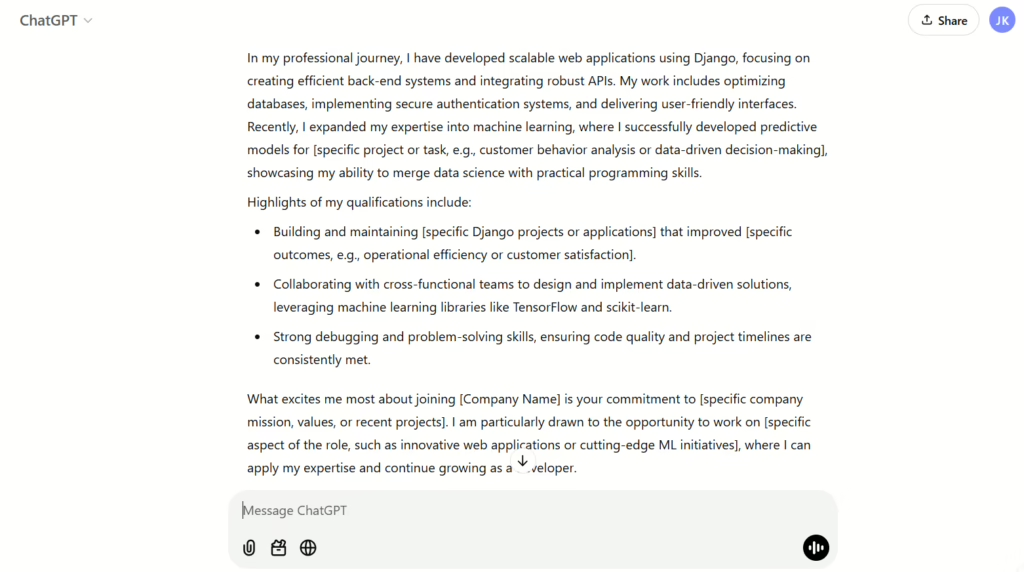
So, how would you integrate this capability into your business? Simply give your staff access to AI, whether Copilot, ChatGPT or something else. And train your staff on how to use it effectively and safely.
What’s not clear with this option: what is the real productivity benefit? I suspect it might be neutral, or marginal at best. While the writing might be more eloquent, AI writing is more verbose, and in many cases could be less effective that straight-to-the-point but less eloquent human writing. It has a tone of writing that is recognisable as AI content. It also generates the very real possibility of staff overusing AI for writing, not checking it properly and sending communications that are just plain wrong.
Use it to your advantage – but use it wisely.
Three: Image generation for low value content (e.g. social media)
You already know AI can generate images. What can you use that for in your business? One widely applicable way to use them is for low value content, where you might not have the budget or time to get a high-quality image created.
The fact AI can generate images is impressive, but usually they aren’t high enough quality to use on a business website or print media. There are often slightly odd things about them. It can be difficult to get the exact output you desire.
But there are plenty of uses where images can be beneficial, even when it’s not high value. Like what? Adding interest to PowerPoint presentations. Spicing up internal documentation. Or quickly creating images for social media posts.
Equipping your marketing team with the ability to create AI images – e.g. Photoshop, or Copilot – could give your team a capability they didn’t have before.
Four: Discovery-style research
You can use LLMs today for research. But what kind of research, exactly?
The kind of research LLMs are good at is finding out things that are known and well documented, that you don’t know and want to find out. Whereas a search engine will point you to one source at a time, an LLM will summarise information that might be contained in multiple sources.
You do need to check the output though – they are often wrong on basic questions.
Inspired by the book “Shoe Dog”, I asked ChatGPT, Copilot and Google when the first Nike shoe was launched.


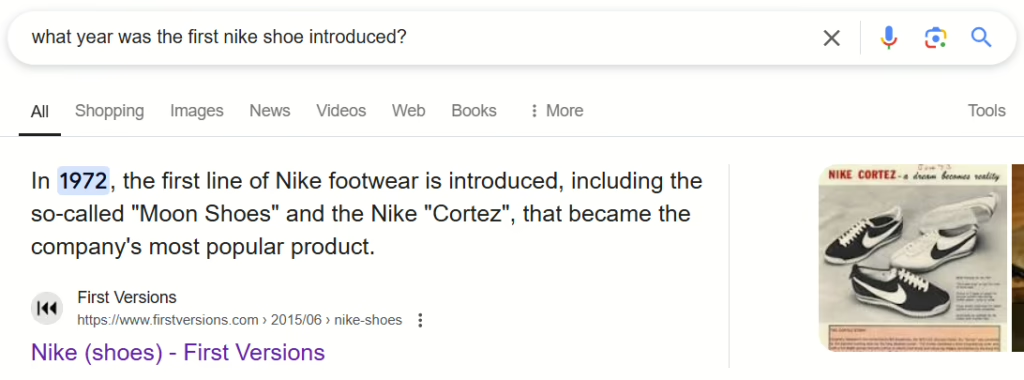
ChatGPT and Google were correct, while Copilot was wrong.
Experiment, and check.
LLMs are good at finding things that can sometimes be challenging to google – multiple searches can be solved with one AI response. See the following example when researching how old a used bicycle might be.
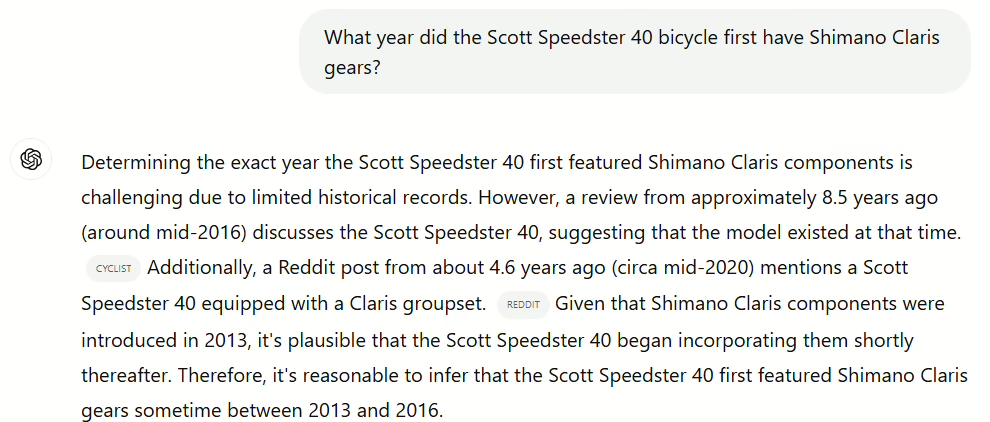
When researching, AI doesn’t find truth – it doesn’t know what truth is – it finds the median answer, the popular answer, from the data it was trained on. It determines this by proximity, not intent – which would be why Copilot thought the first Nike shoe was in 1964, which was when Blue Ribbon Sports imported the first Onitsuka shoe, not when the first Nike shoe was released.
If the training data has bias, or the model is designed to be biased in line with the views of who created the model, it will respond as such.
AI doesn’t do well with finding out true facts that are not common knowledge yet. This has been a critical part of continual human scientific advancement, and still is today – like discovering the earth is round when everyone thinks it’s flat, or that stomach ulcers are caused by bacteria, not stress.
AI also doesn’t do primary research. It won’t run an experiment, or properly analyse research papers the way a human would.
AI won’t analyse your specific situation like an expert can2.
So don’t expect more from AI than it’s capable of.
In practical use, people can use AI bots in a similar way to how they use Google – to find information. While the information can come back faster, in my experience it’s less trustworthy than a search.
Five: Summarisation
LLMs are summarisation machines. When an LLM is created, it’s fed a large volume of data, and builds a neural network to map it out. When you query an LLM, it’s summarising. A lot of the data that an LLM is trained on are documents that contain – well – summaries. So they’ve seen a lot of summaries.
LLMs are good at summarising content they’ve been trained on, but also content you upload to it.
AI is surprisingly good at summarising images. If you process a lot of images, and would benefit from a searchable text description of what is in those images, AI is great for that.
Unfortunately, I’ve so far found that the ability for AI to summarise short, context dependent content – like emails – can be quite weak. The summary is usually unpleasantly verbose, and often doesn’t contain the most important elements of what was being summarised.
The real value of AI’s summarisation ability is going to depend on the business. If you need to describe a lot of images – e.g. for web content – or review a significant number of long papers, summarisation is going to be useful.
If writing a critical summary though – like an executive summary for a proposal, or board paper – I’d recommend you make sure you write it yourself, to get your most critical points across to the reader.
Final thoughts
This article just provides a snapshot of common things AI can do for business in early 2025. It’s not an exhaustive list. There are plenty more useful things AI can do, many of which involve integrating AI capabilities into your business’s software & data, by writing code that connects to AI via API3.
Keep in mind AI models are constantly improving. New capabilities come out frequently, but more often new models improve the quality of the AI’s work, rather than introducing new capabilities. While there’s a lot of noise around AI, the actual pace of future improvements is unclear. A really good way to determine what AI is ready to integrate into your business is to look at what the tech giants are doing at scale in their own products.
When looking at your own business, how do you most readily identify what to use AI for?
Instead of asking: “What can I use AI for?”
Try asking: “What is laborious and slow in my business, and how can I make it better, high quality and faster?”
That’s how you find what will make the most impact, whether AI is involved in the solution or not.
- It would be more accurate to say that AI helps humans who can’t write well, write better. Good human writing is still more engaging than AI writing. ↩︎
- But would likely give you a better response than just using search. ↩︎
- For non-technical readers: An API, Application Programming Interface, is the standard way that software developers connect software together. ↩︎